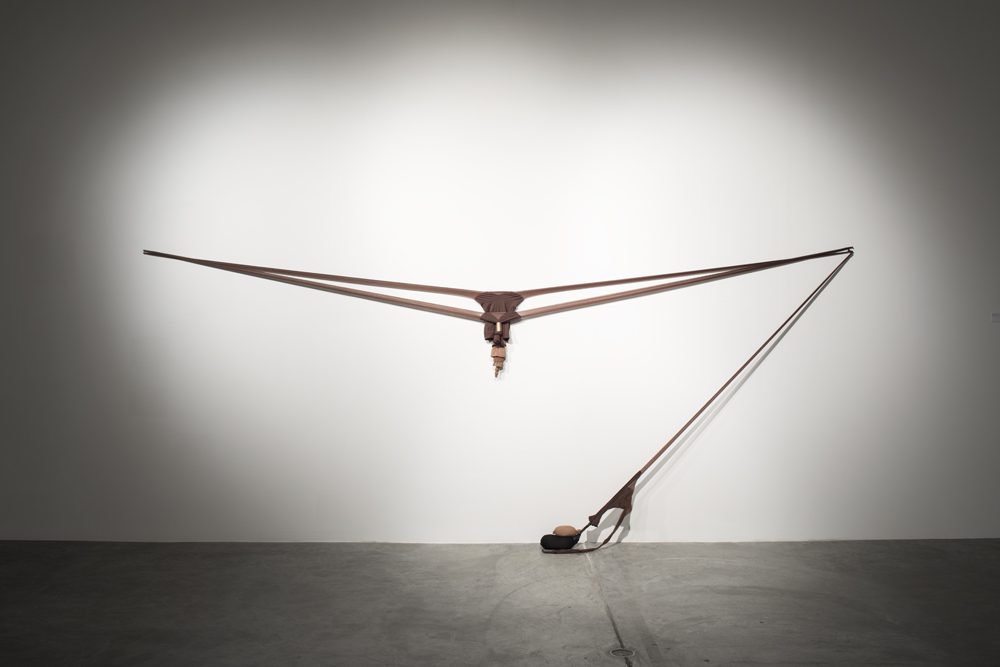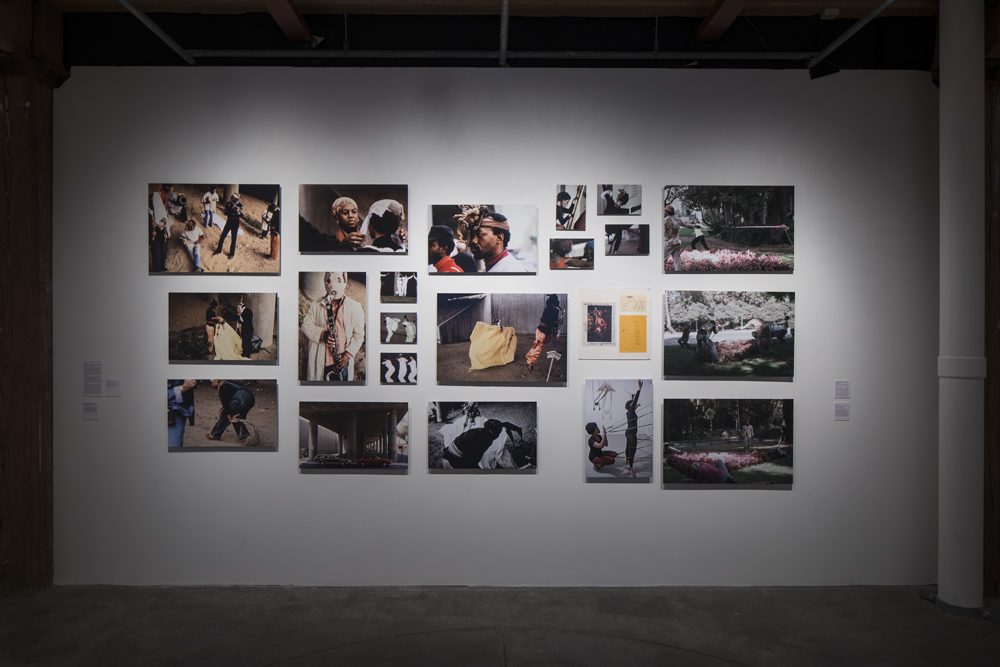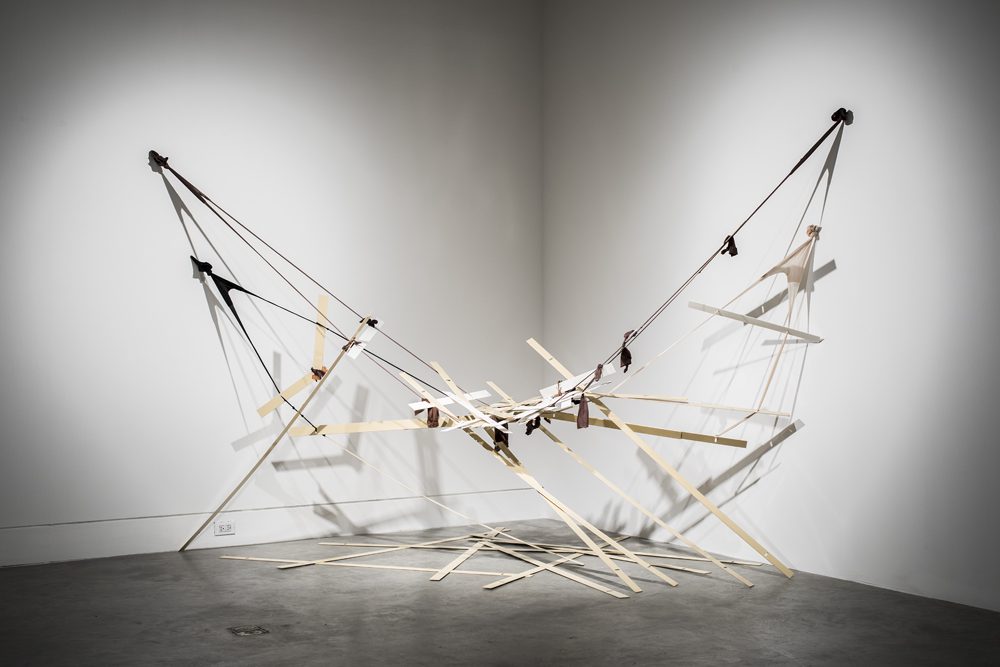The Power of Movement: Senga Nengudi at the Contemporary Arts Center
Allison Glenn explores how collaboration, performance, and the body are integral parts of Senga Nengudi’s practice, which is documented in an exhibition at the Contemporary Arts Center.

Installation view of Senga Nengudi’s R.S.V.P. Reverie ‘D’, 2014, at the Contemporary Arts Center, New Orleans. Nylon mesh, sand, and copper. Courtesy the artist. Photo by Alex Marks.
The interdisciplinary practice of Senga Nengudi is deeply rooted in the confluence of performance, ritual, and corporeal objects. In 1978, Nengudi orchestrated Ceremony for Freeway Fets, an improvisational, collaborative performance underneath the interstate overpass on Pico Boulevard in downtown Los Angeles. It was a ritualistic offering inspired by the sparse landscape and vegetation found underneath the bridge. Nengudi adorned the minimalist concrete support columns and the bodies of her collaborators, including artists Maren Hassinger and David Hammons, with her signature soft sculptures. Hanging like luscious fruit, their anthropomorphic forms are also reminiscent of asafetida sacks.
Ceremony for Freeway Fets was made possible through funding from an Art in Public Spaces grant administered by Brockman Productions, the curatorial arm of Brockman Gallery. Art in Public Spaces grants were made a part of the Comprehensive Employment and Training Act (CETA), a congressional law signed by President Nixon in 1973. Integral to the art community in and around South Los Angeles at that time, Leimert Park-based Brockman Gallery was co-directed by artists, educators, and brothers Dale Brockman Davis and Alonzo Davis. Collaboration, community, and support were entrenched in the ethos of the gallery, which gave exhibition opportunities and representation to many artists who were overlooked by mainstream museums and commercial galleries at that time. Notable names who had seminal exhibitions at Brockman include Noah Purifoy, Nengudi, Hassinger, and Hammons, all of whom have gone on to become prominent and legendary figures in contemporary art.

Installation view of Senga Nengudi’s “Improvisational Gestures” at the Contemporary Arts Center, New Orleans. Courtesy the artist. Photo by Alex Marks.
Documentation from the performance of Ceremony For Freeway Fets hangs in a central room in the second-floor galleries of the Contemporary Arts Center, where Nengudi’s touring solo exhibition and first comprehensive survey “Improvisational Gestures,” curated by Elissa Auther and Nora Burnett, is currently on view. Within this intimate space, Nengudi’s longtime performance practice unfolds. The collection of ephemera in this room includes documentation from Flying, 1982, a performance for the opening of April Kingsley’s exhibition “Afro-American Abstractions” at the Municipal Art Gallery in Barnsdall Park in Los Angeles. True to her collaborative approach, Nengudi was joined by Hassinger, filmmaker Ulysses S. Jenkins, Frank Parker, and others. During the multimedia performance, images of flying birds were projected onto the white-clothed bodies of the performers while they moved from the museum out into the courtyard space, each holding slats of venetian blind, which, as art historian Kellie Jones notes in South of Pico: African American Artists in Los Angeles in the 1960s and 1970s was the same material found in a sculpture that Nengudi was exhibiting within the gallery. For Jones, Flying “evinced Nengudi and Hassinger’s fascination with forms in space, whether sculptural or human.”
The relationship between material, memory, and the body is explored throughout “Improvisational Gestures.” Nuki Nuki: Across 118th St., 1982 is a sculpture made of nylons, window blinds, and nails that was recreated from a 1982 performance of the same name. The performance, and subsequent sculpture, were inspired by what Nengudi has described as living conditions in Harlem in the 1970s and 1980s, “held together by a hope and a prayer.” The anthropomorphic, leggy silhouette of Untitled (R.S.V.P.), 2013, is a commentary on the body through stages of life, such as birth, pregnancy, and aging. Five elongated pairs of nylon mesh stockings of various skin tones are stretched from the wall to the floor, weighted by sand. The feet of the nylons are precariously placed on top of one another, the arrangement evocative of dancers on stage.

Installation view of Senga Nengudi’s Nuki Nuki: Across 118th St., 1982, 1982/2014, at the Contemporary Arts Center, New Orleans. Nylon mesh and wooden slats. Courtesy the artist. Photo by Alex Marks.
As curator Naomi Beckwith states in “Dark Mirrors: Performance Documents as Bodily Evidence,” from the catalogue Radical Presence: Black Performance in Contemporary Art, there is a prominent relationship between sculpture and the body in Nengudi’s practice that “is deeply informed by a bodily knowledge of how physical presences inhabit a three-dimensional space.” Many of her sculptures were originally meant to be activated by the body, and some, like Nuki Nuki, were created through Nengudi’s performance practice, a fact that was highlighted through programs at the exhibition’s previous venues. Unfortunately, by the time “Improvisational Gestures” made its way to New Orleans, there were enough concerns about the fragility of the sculptures to prevent further interaction.
During opening night, Nengudi was in conversation with longtime collaborator Hassinger. There was a palpable intimacy between the artists, clearly developed through years of working together. Conversation turned to the body, and what Hassinger described as, “the power of movement” to defy bodies and body types. Nengudi revealed that she was dissuaded from pursuing dance for not possessing what was then determined to be the “correct” body type for the profession. As Jones notes in her book, the aforementioned Flying marked a moment of many movements, and Hammons’, Hassinger’s, and Nengudi’s explorations of the landscape of Los Angeles and their subsequent influence on the New York art world perhaps provide the most resonant examples of the power of movement.
Editor's Note
Senga Nengudi’s “Improvisational Gestures” is on view through June 18, 2017, at the Contemporary Arts Center (900 Camp Street) in New Orleans.



